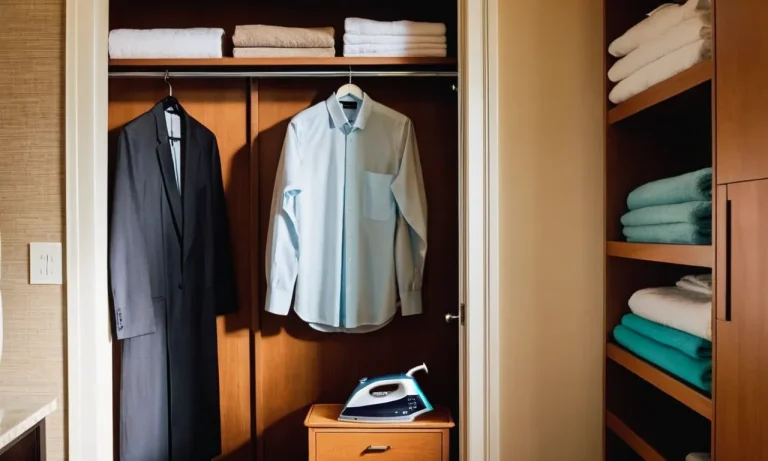Is It Possible To Smoke In A Room With A Smoke Detector?
Smoking indoors has become a contentious issue, with many establishments and households implementing strict no-smoking policies. However, some individuals may still find themselves wondering if it’s possible to smoke in a room with a smoke detector without triggering an alarm.
This question raises concerns about safety, legality, and potential consequences.
If you’re short on time, here’s a quick answer to your question: While it is technically possible to smoke in a room with a smoke detector, it is generally not recommended or advisable due to potential health risks, legal implications, and the likelihood of triggering the smoke alarm.
In this comprehensive article, we’ll delve into the intricacies of smoke detectors, the factors that influence their sensitivity, and the potential risks associated with smoking indoors. We’ll also explore alternative solutions and best practices to ensure a safe and legal environment for smokers and non-smokers alike.
Understanding Smoke Detectors
Smoke detectors are an essential safety device found in most homes and buildings. They play a crucial role in detecting the presence of smoke, which can be an early indicator of a fire. Understanding how smoke detectors work and the factors that affect their sensitivity is crucial for ensuring their proper functioning and maximizing their effectiveness in protecting lives and property.
Types of Smoke Detectors
There are two main types of smoke detectors: ionization smoke detectors and photoelectric smoke detectors. Ionization smoke detectors are more sensitive to smaller, invisible smoke particles produced by fast-burning fires, such as those caused by flaming materials like paper or wood.
On the other hand, photoelectric smoke detectors are better at detecting larger, visible smoke particles generated by smoldering fires, such as those caused by upholstered furniture or bedding.
According to the National Fire Protection Association (https://www.nfpa.org/Public-Education/Staying-safe/Safety-equipment/Smoke-alarms), having both types of smoke detectors installed in your home provides the best protection against different types of fires.
Many modern smoke detectors combine both ionization and photoelectric sensors into a single unit, providing comprehensive protection.
How Smoke Detectors Work
Smoke detectors work by sensing the presence of smoke particles in the air. Ionization smoke detectors contain a small amount of radioactive material that ionizes the air between two electrically charged plates, allowing a small current to flow between them.
When smoke enters the chamber, it disrupts the flow of ions, reducing the current and triggering the alarm.
Photoelectric smoke detectors, on the other hand, use a light source and a light sensor positioned at an angle to each other. When smoke enters the chamber, it scatters the light beam, causing the light sensor to detect the scattered light and activate the alarm.
Factors Affecting Smoke Detector Sensitivity
Several factors can affect the sensitivity of smoke detectors, including:
- Age of the detector: Smoke detectors have a limited lifespan, typically around 8-10 years. As they age, their sensitivity decreases, and they may need to be replaced.
- Dust and debris: Accumulation of dust and debris inside the smoke detector can reduce its sensitivity and potentially cause false alarms.
- Environmental conditions: High humidity, temperature, and air pressure can affect the performance of smoke detectors.
- Placement: The location and positioning of the smoke detector can impact its ability to detect smoke effectively. Detectors should be installed on every level of the home, including the basement, and near sleeping areas.
Regular testing and maintenance of smoke detectors are crucial to ensure they are functioning properly and providing adequate protection. It’s recommended to test your smoke detectors monthly and replace the batteries annually or as needed.
Don’t take chances when it comes to fire safety – a well-maintained smoke detector can save lives! 👏🎉
Risks of Smoking in a Room with a Smoke Detector
Health Hazards
Smoking in an enclosed space, such as a room with a smoke detector, can pose severe health risks to both smokers and non-smokers alike. Secondhand smoke, which is the combination of smoke from the burning end of a cigarette and the smoke exhaled by the smoker, contains over 7,000 chemicals, including hundreds that are toxic and at least 70 that are known to cause cancer, according to the Centers for Disease Control and Prevention (CDC).
Exposure to secondhand smoke can increase the risk of lung cancer by 20-30% and heart disease by 25-30%. Additionally, it can cause respiratory problems, such as coughing, wheezing, and asthma attacks, especially in children and the elderly.
Fire Safety Concerns
Smoking in a room with a smoke detector can also raise significant fire safety concerns. While smoke detectors are designed to alert you to the presence of smoke, they do not prevent fires from occurring.
In fact, smoking materials, including cigarettes, cigars, and pipes, are the leading cause of residential fire deaths in the United States, according to the National Fire Protection Association (NFPA).
Smoking in a room can increase the risk of accidental fires, as cigarettes or other smoking materials can ignite nearby combustible materials, such as furniture, curtains, or bedding. Additionally, if a fire does occur, the presence of smoke in the room can delay the activation of the smoke detector, potentially leading to more severe damage or injury.
Legal Implications
In many areas, smoking in certain indoor spaces, including residential buildings, is prohibited by law. These laws are designed to protect the health and safety of both smokers and non-smokers alike. Violating these laws can result in fines or other legal consequences.
Furthermore, smoking in a room with a smoke detector can potentially invalidate your insurance coverage in the event of a fire, as it may be considered negligent behavior. It’s always best to check your local laws and regulations, as well as your insurance policy, to understand the legal implications of smoking in a room with a smoke detector.
Strategies for Smoking Indoors
Smoking indoors can be a challenging task, especially in places where smoke detectors are installed. However, there are several strategies that can help minimize the risk of setting off these alarms and reduce the harmful effects of secondhand smoke.
It’s important to note that smoking indoors is generally not recommended due to the potential health risks and fire hazards it poses. Nonetheless, if you choose to smoke indoors, it’s crucial to take appropriate precautions.
Ventilation and Air Purification
Proper ventilation and air purification systems can be effective in removing smoke particles from indoor spaces. Investing in a high-quality air purifier with HEPA filters can help capture and filter out smoke particles, reducing the concentration of harmful pollutants in the air.
Additionally, opening windows and using exhaust fans can help circulate fresh air and remove smoke from the room. According to the Environmental Protection Agency (EPA), effective ventilation and air purification can significantly improve indoor air quality.
Smoke-Free Alternatives
Considering smoke-free alternatives to traditional cigarettes can be a safer option for indoor smoking. Electronic cigarettes (e-cigarettes) and vaporizers produce vapor instead of smoke, which can be less likely to trigger smoke detectors.
However, it’s important to note that the long-term health effects of vaping are still being studied, and some jurisdictions have regulations in place regarding their use indoors. Additionally, nicotine replacement therapies like gum, lozenges, or patches can provide a nicotine fix without producing smoke or vapor.
According to a study by Hartmann-Boyce et al., these alternatives can be effective in helping smokers quit or reduce their cigarette consumption.
Designated Smoking Areas
If smoking indoors is unavoidable, it’s recommended to establish a designated smoking area within the premises. This area should be well-ventilated, equipped with air purifiers, and situated away from smoke detectors to minimize the risk of false alarms.
Proper signage and ashtrays should be provided to ensure smokers use the designated area responsibly. Additionally, consider installing smoke detectors specifically designed for smoking areas, which have higher sensitivity thresholds to prevent false alarms.
According to a survey by the Centers for Disease Control and Prevention (CDC), 😊 over 60% of workplaces in the United States have implemented designated smoking areas or policies to protect non-smokers from secondhand smoke.
Remember, while these strategies may help minimize the risks associated with indoor smoking, the best approach is to quit smoking altogether or to smoke outdoors in designated areas. Smoking indoors can pose significant health risks to both smokers and non-smokers, and it’s important to prioritize the well-being of everyone involved.
👍
Best Practices and Recommendations
Respecting Non-Smokers’ Rights
Smoking in a room with a smoke detector can be a contentious issue, as it involves balancing the rights of smokers and non-smokers. While smokers may desire the ability to indulge in their habit, non-smokers have the right to breathe clean air and avoid exposure to secondhand smoke.
According to the Centers for Disease Control and Prevention (CDC), secondhand smoke contains more than 7,000 chemicals, hundreds of which are toxic and at least 70 are known to cause cancer. It’s crucial to respect the rights of non-smokers and prioritize their health and well-being.
Adhering to Local Laws and Regulations
Many jurisdictions have implemented laws and regulations governing smoking in public places, including residential buildings. These laws aim to protect the health of residents and ensure a safe living environment.
It’s essential to research and comply with local ordinances and building policies regarding smoking. Some buildings may prohibit smoking entirely, while others may designate specific areas for smoking. Violating these rules can result in fines or even eviction.
Stay informed about the latest regulations by checking authoritative sources like the Environmental Protection Agency (EPA) or your local government websites.
Promoting a Safe and Healthy Environment
Beyond legal requirements, promoting a safe and healthy environment should be a priority. Smoking in a room with a smoke detector can be a fire hazard, as the smoke particles can trigger the alarm, leading to unnecessary evacuations and potential safety risks.
Additionally, smoking can leave lingering odors and residue, which can be difficult to remove and may cause discomfort or health issues for others. Consider exploring alternatives like designated outdoor smoking areas or cessation programs to maintain a clean and comfortable living space for all.
According to the Smoking Cessation Leadership Center, quitting smoking has numerous benefits, including improved respiratory function, reduced risk of heart disease and cancer, and increased life expectancy.
👏 Prioritizing the well-being of all residents can foster a harmonious and supportive community.
Remember, respecting non-smokers’ rights, adhering to local laws and regulations, and promoting a safe and healthy environment are essential considerations when it comes to smoking in a room with a smoke detector. By embracing these best practices, we can create a more inclusive and considerate living space for everyone.
😊
Conclusion
Smoking in a room with a smoke detector is a complex issue that requires careful consideration of various factors, including health risks, fire safety, and legal implications. While it may be technically possible to smoke without triggering the alarm, it is generally not recommended due to the potential dangers and consequences.
Instead, smokers should explore alternative solutions, such as designated smoking areas, smoke-free alternatives, or implementing proper ventilation and air purification systems. Ultimately, respecting the rights of non-smokers, adhering to local laws and regulations, and promoting a safe and healthy environment should be the top priorities for both smokers and non-smokers alike.







